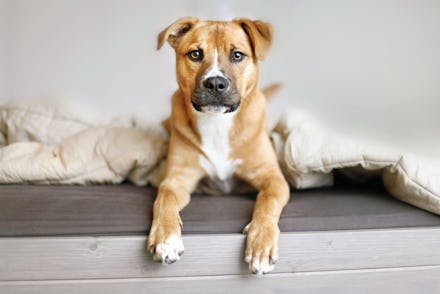Should I get my dog an anxiety blanket?

I love my weighted blanket. While it doesn’t altogether banish my anxiety, it does make finding my chill a little easier — and apparently some dog might relate. During a few recent Instagram scroll seshes, I’ve noticed people using weighted blankets to calm their fur babies too, adding to an array of anxiety gear that also includes pressure wraps and compression hoodies. But does anxiety gear such as weighted blankets work for dogs?
First, a quick rundown of the anxiety gear humans have been using to soothe their high-strung puppers: Weighted blankets, which have been especially buzzy as of late, contain glass or plastic pellets that cause them to drape about 10 to 30 pounds of weight onto the body, SELF explains. Pressure wraps, which resemble vests or shirts, also apply pressure to the body, as do compression hoodies, although they focus pressure on the head.
M. Leanne Lilly, an assistant professor in the Behavioral Medicine Clinic at the Ohio State University College of Veterinary Medicine, compares their effect to that of swaddling a baby. “That sense of very even pressure creates a sense of calmness and safeness,” she says. Julie Kolzet, a New York City-based psychologist and sleep specialist previously told Mic about findings from a 2013 study that deep touch pressure, the type you'd experience from a hug, boosts activity of the parasympathetic nervous system, which plays a role in digestion and rest.
Not unlike weighted blankets, anxiety gear is useful mainly as a complement to interventions like medication.
A number of studies have looked at moderate-to-deep pressure on soft tissue as a way to lower anxiety and promote relaxation in humans and animals, says Liz Stelow, Chief of Behavior Service at UC Davis Veterinary Medicine. Yet peer-reviewed studies of whether weighted blankets in particular can lower anxiety in humans have yielded mixed results, Lilly points out, and she doesn’t know of any that have examined them in dogs. A handful have looked at Anxiety Wrap and ThunderShirt pressure wraps, though. “In these studies, some dogs show some reduction in anxiety based on measurements of heart rate or anxiety scores,” Stelow says.
But Lilly notes that some of the studies that showed pressure wraps to have an effect lacked a control group, or a group of dogs that didn’t wear them, which would’ve allowed researchers to definitively conclude that the wrap, not other variables, was responsible for the improvements they saw. These studies often relied on owner reports of their puppers’ anxiety, but self-reports aren’t terribly reliable. After all, when people sign up for studies, they often want and expect the intervention to work, which could bias their reports, Lilly says.
Not unlike weighted blankets, anxiety gear is useful mainly as a complement to interventions like medication. It’s fine to try to treat mild anxiety with pressure wraps and the like, but “if those things are not sufficient, owners should seek the help of their veterinarian, as medications may be necessary,” Stelow tells Mic. “Moderate-to-severe anxiety usually requires medication to alleviate the emotional pain the pet is experiencing. The role of wraps or blankets in these cases would be a supporting one.”
If you’re considering anxiety gear for your very good, but very nervous, boy or girl, Lilly suggests keeping their coping mechanisms in mind. Anxiety gear might comfort your dog if they seek small spaces when they’re scared, say, by burrowing into your lap, digging into their crate, or hiding behind the sofa. But if they tend to cope by going apeshit, then you might want to skip the anxiety gear. Sure, it might lower their activity level, but their cortisol and heart rate might still be through the roof, in which case it would essentially amount to a paralyzing, full-body bandage, Lilly says (which sounds terrifying, and a bit cruel).
If you think anxiety gear makes sense for your pupper, and you want to test out a weighted blanket on them, scale the blanket’s size and weight accordingly. Your dog should still be able to climb out from beneath it. “Because these are human products, it’s possible there is no weighted blanket safe for a very small dog,” Stelow says.
A pressure wrap like the ThunderShirt or Anxiety Wrap is safe if it fits well, and your dog is cool with wearing it, which is to say, not frozen stiff or panicking, she adds. But Lilly says they’re probably not a good idea if you have a squishy-faced dog like a pug, English Bulldog, or Boston Terrier — breeds that aren’t good at regulating their body temperature. A pressure wrap, which is made with a fair amount if fabric, would increase their heat retention and make them prone to heat stroke.
If you’re considering anxiety gear for your very good, but very nervous, boy or girl, keep their coping mechanisms in mind.
As a general rule, if you dress your dog in a pressure wrap, you’ll want to supervise them and make sure their thermal needs are met. But that’s especially the case if they have poor thermoregulation — meaning that leaving your English Bulldog home alone in a ThunderShirt because you think it’ll soothe their separation anxiety “is one too many risks to take,” Lilly says. She adds that your dog might also find a pressure wrap uncomfortable if they’re particularly wrinkly (you're welcome for that cute image).
For your first anxiety gear test run, Stelow suggests borrowing the gear from a friend, in case your dog isn’t into it, or it has no effect. And importantly, try it without a stressor first, that is, before a thunderstorm hits; “they should still be willing to do fun, positive things,” not turn into a statue, Lilly says. Like many human wellness products, anxiety gear isn’t a panacea, but it can help, depending on your fur baby’s unique needs.